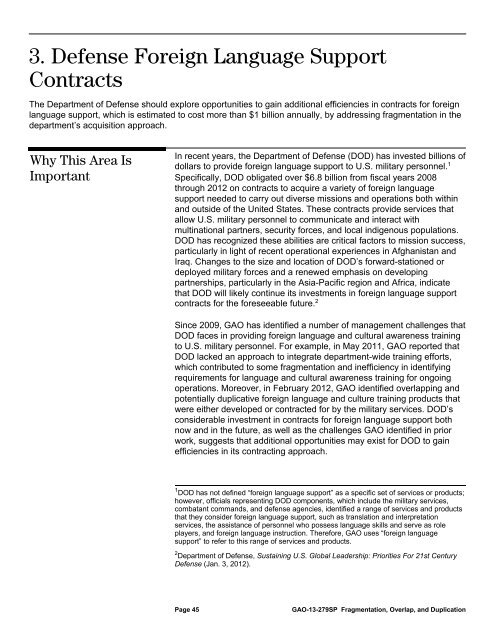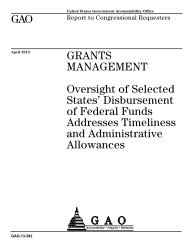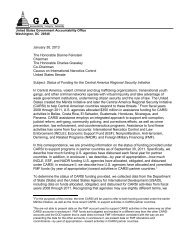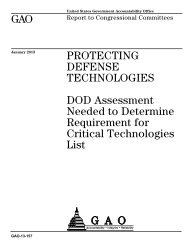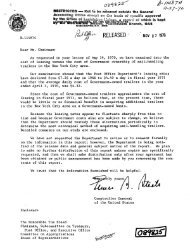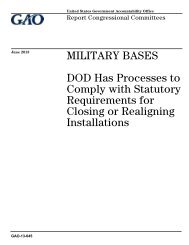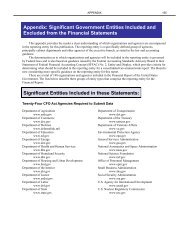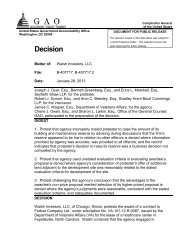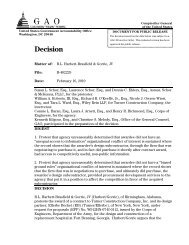GAO-13-279SP, 2013 Annual Report - US Government ...
GAO-13-279SP, 2013 Annual Report - US Government ...
GAO-13-279SP, 2013 Annual Report - US Government ...
Create successful ePaper yourself
Turn your PDF publications into a flip-book with our unique Google optimized e-Paper software.
3. Defense Foreign Language Support<br />
Contracts<br />
The Department of Defense should explore opportunities to gain additional efficiencies in contracts for foreign<br />
language support, which is estimated to cost more than $1 billion annually, by addressing fragmentation in the<br />
department’s acquisition approach.<br />
Why This Area Is<br />
Important<br />
In recent years, the Department of Defense (DOD) has invested billions of<br />
dollars to provide foreign language support to U.S. military personnel. 1<br />
Specifically, DOD obligated over $6.8 billion from fiscal years 2008<br />
through 2012 on contracts to acquire a variety of foreign language<br />
support needed to carry out diverse missions and operations both within<br />
and outside of the United States. These contracts provide services that<br />
allow U.S. military personnel to communicate and interact with<br />
multinational partners, security forces, and local indigenous populations.<br />
DOD has recognized these abilities are critical factors to mission success,<br />
particularly in light of recent operational experiences in Afghanistan and<br />
Iraq. Changes to the size and location of DOD’s forward-stationed or<br />
deployed military forces and a renewed emphasis on developing<br />
partnerships, particularly in the Asia-Pacific region and Africa, indicate<br />
that DOD will likely continue its investments in foreign language support<br />
contracts for the foreseeable future. 2<br />
Since 2009, <strong>GAO</strong> has identified a number of management challenges that<br />
DOD faces in providing foreign language and cultural awareness training<br />
to U.S. military personnel. For example, in May 2011, <strong>GAO</strong> reported that<br />
DOD lacked an approach to integrate department-wide training efforts,<br />
which contributed to some fragmentation and inefficiency in identifying<br />
requirements for language and cultural awareness training for ongoing<br />
operations. Moreover, in February 2012, <strong>GAO</strong> identified overlapping and<br />
potentially duplicative foreign language and culture training products that<br />
were either developed or contracted for by the military services. DOD’s<br />
considerable investment in contracts for foreign language support both<br />
now and in the future, as well as the challenges <strong>GAO</strong> identified in prior<br />
work, suggests that additional opportunities may exist for DOD to gain<br />
efficiencies in its contracting approach.<br />
1 DOD has not defined “foreign language support” as a specific set of services or products;<br />
however, officials representing DOD components, which include the military services,<br />
combatant commands, and defense agencies, identified a range of services and products<br />
that they consider foreign language support, such as translation and interpretation<br />
services, the assistance of personnel who possess language skills and serve as role<br />
players, and foreign language instruction. Therefore, <strong>GAO</strong> uses “foreign language<br />
support” to refer to this range of services and products.<br />
2 Department of Defense, Sustaining U.S. Global Leadership: Priorities For 21st Century<br />
Defense (Jan. 3, 2012).<br />
Page 45<br />
<strong>GAO</strong>-<strong>13</strong>-<strong>279SP</strong> Fragmentation, Overlap, and Duplication


